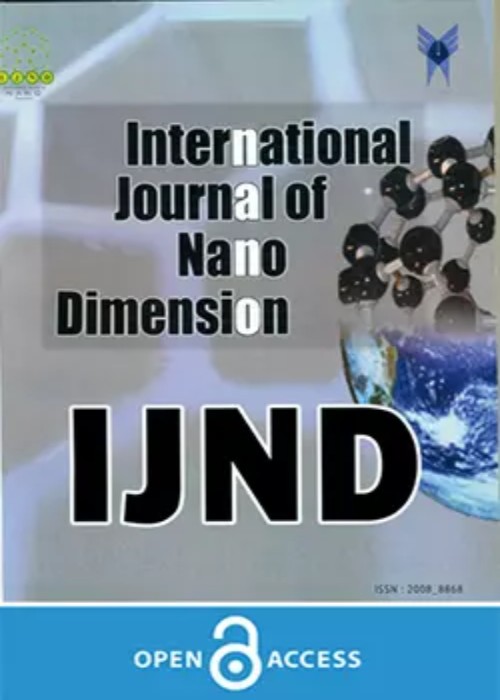فهرست مطالب

International Journal of Nano Dimension
Volume:1 Issue: 2, Autumn 2010
- تاریخ انتشار: 1389/06/01
- تعداد عناوین: 8
-
Page 89Carbon nanotubes (CNTs) are high aspect ratio allotropes of carbon. Because of their unique physical and chemical characteristics, they are nominated for a vast variety of applications in the biomedical field. Their very low solubility is the only problem of them which is solved by different methods of Functionalization. After discoveries in the last few years of the capacity of CNTs to penetrate into the cells, and because of the low toxicity they display and are not immunogenic, CNT are known to have impressive potentials to be used as drug and medicine carriers and therefore they hold great potential in the field of nanobiotechnology and nanomedicine. CNTs can be functionalized with different therapeutic molecules and internalized by a variety of cell types to deliver therapeutic and diagnostic small molecules and macromolecules to cells. In this review, we will describe the potential of functionalized carbon nanotubes to deliver different types of therapeutic molecules.
-
Page 103Hydroxyapatite is a biocompatible ceramic and reinforcement for bone implantations. SEVA/HAP composite content HAP filler with difference particle sizes were designed. Mechanical tests like tensile modulus, UTS, strain at break and biodegradation were investigated. Results illustrated much increase tensile modulus of composites content HAP nano powders ratio to micro powders. Also UTS analysis of composites illustrated much increase UTS of composites content HAP nano powders ratio to micro powders and strain at break analysis of composites illustrated much decrease of strain at break composites content HAP nano powders ratio to micro powders. The composites degradation in PBS solution showed slowly degradation time of composites content HAP nano powders ratio to micro powders filler.
-
Page 111LiNi0.5Co0.5VO4 has been successfully synthesized by tartate precursor combustion method using Li2CO3, Co(NO3)2.6H2O, Ni(NO3)2.6H2O and NH4VO3 as a starting materials in deionized water with the subsequent calcination at 450-600 oC for 12 h. The combustion and decomposition of tartate precursor were studied by TGA and compared with tartaric acid. It found weight loss at 50-450 oC. The product showed a inverse spinel LiNi0.5Co0.5VO4 which confirmed by PXRD. The crystal and particle sizes improved when calcination temperature was increased. Raman and FITR were studied the vibration of product. They detected V-O stretching in VO4 tetrahedron, Li-O bending in LiO6 octahedron and Li-O-M (M = Ni and Co) stretching. The TEM showed morphologies that composed nano-particle of LiNi0.5Co0.5VO4.
-
Page 119We consider of the antimicrobial activity on the Ag-nanoparticles(Ag-NPs) aqueous solutions, which was prepared using a stabilizer, such as poly(N-vinyl-2-pyrrolidone) (PVP (, for Staphylococcus aureus) S. aureus (and Escherichia coli)E.coli (by measuring the minimum inhibitory concentration)MIC(. Antimicrobial effect of Ag-NPs for S. aureus and E. coli was investigated using disk diffusion method. Also, the Ag-NPs did show the antimicrobial activity for the test organisms. Antibacterial activity of Ag-NPs was found to be dependent on the shape of bacteries.
-
Page 125CoTiO3-clay nano-composites were synthesized via a conventional sol-gel method; the gel was calcinated at 500 - 800°C for 2 hours. The presence of rhombohedra phase of CoTiO3 in clay matrix was confirmed by XRD, FTIR, SEM. Cobalt titanate-clay nano-composites were prepared with 5-20%(w/w) by sol-gel method. The spectra results were investigated at 20% (w/w) concentration. The optimum condition for nano-composite preparation in 20 %(w/w) at 600°C is obtained.
-
Page 133According to the unique properties and many applications of nano silver powder, it was prepared from acid leaching tail solution. The low value residual gold and silver ions were occurred with fellow heavy metals as pollutants (Fe2+, Cu 2+ and Zn2+) in acid leaching tail solution in Mouteh gold mine in Iran. Preparation of nano silver particles was achieved in two steps: first, by addition of ammonia as a separation step and second by using different reagents as precipitation and extraction steps. Different controlled parameters were including pH, residence time and temperature, mixing time, and reducing reagents to metals molar ratio. Acid leaching process was carried out with sulphuric and nitric acid via suitable reductants. In order to remove copper, zinc, and silver ions from solution, all of the conditions were controlled. The optimum conditions for preparation of nano silver powder with less than 90 nm were pH 10.5, hydrazine/methanol to silver molar ratio of 3 to 4, and reduction time of 5 min in 45ºC. The results were evaluated via SEM, A.A and UV- Vis spectroscopy analytical methods.
-
Page 143The reduction capacity of ammonia while present even at ppm level can be demonstrated by the increased encounter probability between ammonia and methylene blue dye (MB+) incorporated in nanomordenite and Na-MOR zeolites. The rate of reduction methylene blue dye by ammonia on the surface nanomordenite zeolite is faster than Na-mordenite (Na-MOR) zeolite.Because nanomordenite zeolite with high silica (Si/Al=15) and surface area 400 (m2/g) is referred to as hydrophobic support with respect to Na-MOR zeolite (Si/Al=6.5). On the other hand, the rate of color bleaching of MB+ by ammonia was found to be fastest in proton form of nanomordenite and mordenite zeolites. The results obtained with the zeolites were also compared with non-ionic micelle (TX-100). The calibration graph is valid for wide range of concentrations in nanomordenite zeolite. The limit of detection (LOD) is 0.12 mg ml-1. This method is simple, sensitive and easy to carry out. By using only a UV-visible spectroscopy, ammonia can be quantified.
-
Page 153In this paper, the chemical functionalization of carboxylated multi-walled carbon nanotubes (MWNT-COOH) by 1,2-phenylenediamine, have been investigated. MWNT-benzimidazole is obtained through MWNT-Amide reaction with POCl3 after 72h, which is confirmed by FT-IR, SEM, TGA, and elemental analysis. These functionalizations have been chosen due to –NH2 and NHCO active sites in MWNT-Amide for future application.


